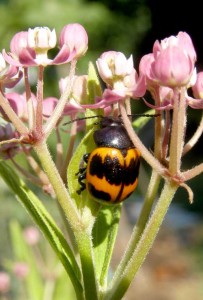See who’s coming to dinner!
By Ken Moore
“Look what’s in my garden!†That email last week from friend Pete accompanied an image of a beautiful milkweed leaf beetle.
I immediately went out to my garden, where I have two pots of swamp milkweed partially immersed in a little pool tucked in front of the veggie garden, all of which is enclosed by a curiously constructed deer-, rabbit-, groundhog- and raccoon-proof fence.
And, sure enough, there were two beautiful milkweed leaf beetles, as best I could determine with my meager references, Labidomera clivicollis.
Fortunately, Pete already had led me to the likely identification of the beetle that made my investigation much easier. I am in awe of entomologists, who focus on distinguishing characteristics of the thousands and thousands of insect critters all around us. I view insect taxonomy as more complicated than plant taxonomy, but that may be because plants remain stationary. Taking closer looks at the jumping, flying, running insects is something else!
However, this orange-and-black beetle is very accommodating. It doesn’t seem to mind being handled, content to walk around on hand and fingers until placed back on its milkweed. The color and patterns of the beetle are really variable. No two are exactly alike. One of my two is bright orange and the other is yellow.
Their habit is described as feeding and mating on milkweeds. They eat both leaves and flowers, but not enough to cause any real harm. Sometimes you may notice that a leaf is partially broken. The beetles are clever in slitting a leaf vein or two to partially drain the leaf of its toxic milky sap, making the outer part of the leaf a bit tastier for ingestion. Eggs are laid on leaf undersides and larvae drop to the ground to continue their cycle. Larvae are described as sometimes staying around a while to chew on the leaves. The beetle population seems to remain low enough to be respectful of its host milkweed.
Though the beetle will visit the common milkweed, Asclepias syriaca, it prefers the swamp milkweed, Asclepias incarnata. With vivid pink flowers, swamp milkweed occurs naturally, as its name implies, in swamps, along pond edges and in boggy areas throughout the mountains and Piedmont and less commonly in the coastal plain. Its broader distribution is from New England all the way down and around to Texas.
Swamp milkweed makes a nice long-lived garden plant. Just don’t let it linger without moisture too long during droughts. If you pinch off the spent flowers, it will re-bloom several times during the growing season. In addition to the colorful beetles, it attracts butterflies and many desirable pollinators. Niche Gardens keeps it as one of their standard butterfly-attracting perennials and it is still available at the N.C. Botanical Garden.
Whether a milkweed or some other plant attracting your attention with flowers, you’ll most likely find accompanying critters, in many cases, as beautiful and engaging as the flowers.



Comments are closed.